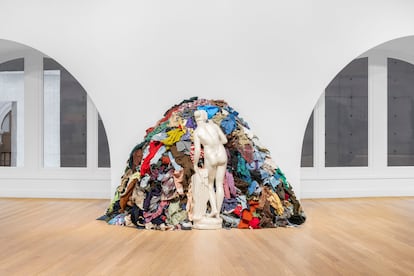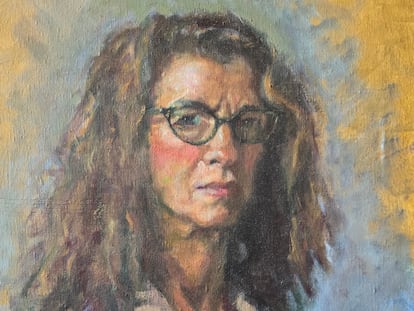Arte povera is back: The unexpected boom in ‘poor’ art that the rich admire
A monumental exhibition dedicated to the avant-garde group of the 1960s is on display at the François Pinault Foundation for Contemporary Art in Paris. The radical Italian movement is setting new records in the market and conquering museums around the world

Arte povera — or “poor art” — will go down in history as one of the most unusual episodes of 20th-century art. The movement, made up of artists such as Michelangelo Pistoletto, Giuseppe Penone, Giovanni Anselmo, and Jannis Kounellis, rebelled against the capitalist system of production and consumption, amid a context of rapid industrialization in 1960s Italy. At the time, the country was in ruins and searching for a new direction.
The mostly Italian artists all used ephemeral and modest materials in their work, such as cardboard, wood, cement, neon lights, old clothes, plastic tarpaulins and newspapers. They distanced themselves from the norms of the art market, while also avoiding dominant trends, such as abstract expressionism, pop art, or minimalism.
The result was a set of modest and eclectic works of art. This is demonstrated by the vast and strange mix of 250 works that are currently part of the exhibition dedicated to arte povera at the Paris Bourse (“stock exchange”). The 19th-century building is home to the foundation set up by billionaire arts patron François Pinault. Until January 20, this circular building — remodeled during the pandemic by Japanese architect Tadao Ando — exhibits mattresses covered in frost, a sack of potatoes, a Doric column with a hose at its base, a motorcycle with cattle horns (instead of handlebars), as well as an array of humble, igloo-shaped structures by Mario Merz. During the final stretch in the installation of the exhibit, Pinault strolled past the igloos, greeting visitors with brief “bonjours.”

An installation by Pistoletto combines a nude Venus with a pile of rags, as if to symbolize the clash between the rich artistic heritage of the Renaissance and the wastefulness of consumer society. Outside, stones grow from a tree — an idea from the mythical Penone — while an ice sculpture melts with the passing of time.
“We wanted to do something that didn’t exist before,” said 80-year-old artist Gilberto Zorio at the opening, standing next to a participatory work that uses microphones to replicate the voices of visitors with a resonant echo. The exhibition tells the story of an avant-garde group that never perceived itself as such. “It wasn’t a movement like surrealism or cubism, because it had no manifesto or leaders. It was more of a current, or a constellation,” says the exhibition’s curator, Carolyn Christov-Bakargiev, an Italian-American art historian known for having orchestrated the 2012 edition of the German contemporary art exhibition Documenta.
The Italian expression arte povera came from the critic Germano Celant. In 1967, he went to see the group’s founding exhibition in Genoa, followed by another in Amalfi a few months later. “The insignificant begins to exist, it imposes itself,” Celant declared, while discovering the works of these provocative artists, who were in their thirties at the time. Their first works — simple, yet provocative in spirit — were characterized by the use of materials typically considered unsuitable for art. However, some of the young artists also used more traditional materials, such as bronze, marble, Murano glass, or even gold. Hence, arte povera is more “an attitude or an intention than a style,” Christov-Bakargiev explains. The works — considered to be precursors of installation art — sought to transform space and alter the environment. “The work becomes a theatrical scene that reflects the energy of life and reality,” the curator adds.

The exhibition links the movement to altissima povertà (or “supreme poverty”) theorized by St Francis of Assisi, who advocated in favor of the renunciation of material goods. He praised the idea of an existence devoted to spiritual life and communion with nature. The strange thing is that this homage to an austere and rebellious movement takes place in Pinault’s private foundation. He’s the third-richest man in France, with 150 works of arte povera in his personal collection. He has donated 50 for the ongoing exhibition.
But Pinault isn’t the only prominent person who’s been interested in this movement. The Prada Foundation in Milan, chaired by another great European collector, Miuccia Prada, recently exhibited the works of Pino Pascali, another great name inscribed in the movement. And, a few years ago, it did the same with artworks by Kounellis.
At the beginning of this year, the Guggenheim Museum in Bilbao opened an exhibition dedicated to Giovanni Anselmo — who died shortly before — while the museum’s New York branch has included several works from the arte povera movement in the new presentation of its collection, which can be visited until January 2025. In mid-October, the Art Basel fair in Paris included numerous works by artists associated with arte povera, while in London, the auction house Christie’s sold a painting by Alighiero Boetti for over $3 million. In 2022, the Italian artist had already reached $9 million in another sale. The world record in this movement is held by one of the so-called “achromes” — or canvases devoid of color — by the Milanese artist Piero Manzoni, a pioneer of the movement. In 2014, someone paid $20 million for one of his paintings.

Over time, works of arte povera have, ironically, become luxury items. In the 1990s, Gianni Agnelli, the patriarch of Italian automobile manufacturer Fiat, purchased samples from the radical movement that was supposed to denounce the actions of men like him in the world.
How can we explain the fact that “poor art” is cheered on today by the richest men and women in the world? “In their time, the popes of Rome bought works by Caravaggio. Power rarely buys art that’s dedicated to celebrating it,” answers Christov-Bakargiev, who recalls that the first collectors she received were middle-managers from Italian or German industries.
Ultimately, the critical attitude towards capitalist excesses may have seduced industrialists with a guilty conscience at the time. Whether they were aware of it or not, supporting this movement allowed them to reshape their image, as if they were burning their wealth in the bonfire of vanity. The connection with modesty and material things reminded them of where they came from: humble, peasant families… origins they had distanced themselves from while building their fortunes.
In the 1960s, Pinault founded the PPR company, the precursor of the current Kering Group. He made his fortune trading in timber, which is the most common material in the exhibition that he’s now presenting at his foundation.
Sign up for our weekly newsletter to get more English-language news coverage from EL PAÍS USA Edition
Tu suscripción se está usando en otro dispositivo
¿Quieres añadir otro usuario a tu suscripción?
Si continúas leyendo en este dispositivo, no se podrá leer en el otro.
FlechaTu suscripción se está usando en otro dispositivo y solo puedes acceder a EL PAÍS desde un dispositivo a la vez.
Si quieres compartir tu cuenta, cambia tu suscripción a la modalidad Premium, así podrás añadir otro usuario. Cada uno accederá con su propia cuenta de email, lo que os permitirá personalizar vuestra experiencia en EL PAÍS.
¿Tienes una suscripción de empresa? Accede aquí para contratar más cuentas.
En el caso de no saber quién está usando tu cuenta, te recomendamos cambiar tu contraseña aquí.
Si decides continuar compartiendo tu cuenta, este mensaje se mostrará en tu dispositivo y en el de la otra persona que está usando tu cuenta de forma indefinida, afectando a tu experiencia de lectura. Puedes consultar aquí los términos y condiciones de la suscripción digital.
More information
Archived In
Últimas noticias
Welcome to the post-religion era: The idea of Christianity as the absolute truth has become obsolete
‘I thought you would like it’: The risky sexual practice popularized by TV shows and TikTok
The digitalization of tourism: ‘They promise experiences and gave us the worst possible one’
Mexican peso defies uncertainty with forecasts of a new period of stability in 2026
Most viewed
- Sinaloa Cartel war is taking its toll on Los Chapitos
- Oona Chaplin: ‘I told James Cameron that I was living in a treehouse and starting a permaculture project with a friend’
- Reinhard Genzel, Nobel laureate in physics: ‘One-minute videos will never give you the truth’
- Why the price of coffee has skyrocketed: from Brazilian plantations to specialty coffee houses
- Silver prices are going crazy: This is what’s fueling the rally











































